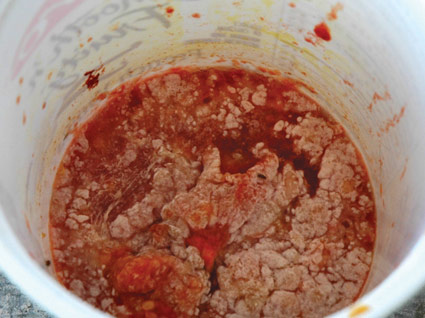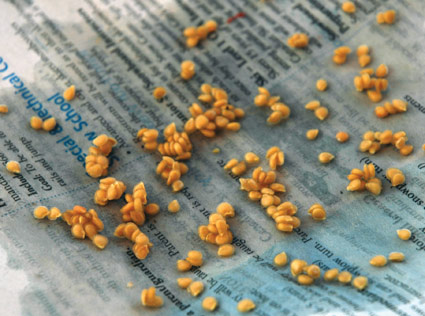It’s mid September and sadly most of the container-grown tomato plants on my rooftop are on their last lap. A few green stragglers remain and the vines are starting to yellow and fade. Thankfully I’ve got another crop still running over at my community garden plot where the plants aren’t subjected to the intense sun and heat that causes the roof plants to hit such an accelerated pace. When the plants were producing at full stride, I was so caught up in enjoying (and photographing) the harvest I completely forgot to save some seeds for next year’s crop.
Of course, it’s not too late. I’ve outlined my process for seed-saving tomato seeds below. The process with very wet fruit like tomatoes is a bit different than with a relatively dry fruit like peppers. While peppers are as simple as scooping out the seeds and setting them to dry, tomatoes call for a slightly more complex method. You can, in theory use the pepper method with tomatoes. However, you may have noticed that tomatoes have a gelatinous layer surrounding each seed. This layer is called a germination inhibitor and is made up of a chemical that prevents the tomato seeds from germinating inside the fruit. While the scoop and dry method will remove that layer, fermenting the seeds first will also serve to kill diseases your plant may have contracted along the way.
Fermenting Tomato Seeds
1. Choose a heathly tomato from a healthy plant – While you’d rather save the best-looking tomatoes for eating, sick fruit from sick plants pass on… well, sickness. And remember, you can always scoop out the seeds for saving and eat the rest.
2. Scoop the insides out of your tomato (seeds and all) into a plastic yoghurt container. A lid isn’t critical but it helps with the smell.
3. Label your container with the variety name and set it somwhere warm but out of direct sun. You can prop the lid on but don’t seal it shut. Remember you’re fermenting here so this is going to stink. Find an out-of-the-way spot if you can.

- It’s READY!
4. Stir your container once or twice a day until a “nice” layer of white mold forms on top. This usually takes a few days. Don’t leave the fermented goo sitting for too long after this stage or your seeds will start to germinate in the container.
5. Your seeds are now ready to harvest. Thankfully you do not have to dig around in this mess in order to fish them out. All of the good seeds will have sunk to the bottom with all the useless stuff left floating in the mold. Separating the good from the bad is as easy as scooping or pouring off the moldy layer from the liquid. Remove as much as you can without losing any of the good seeds.
6. Fill the container with water, stir, and repeat step five. Repeat refilling with water and scooping until all the bad debris has been removed.
7. Rinse off the remaining seeds in a strainer and spread them out onto a pad of newspaper.

8. Set the seeds out to dry for a few days. Don’t forget to label them if you’ve got more than one variety on the go. Take it from me. I always think I’ll remember what I’ve got but I NEVER do.
9. Package your dried seeds, label, and store for next year.
-
More photos can be seen on pages 167-168 of You Grow Girl. All photos by Gayla Trail.
This is excellent, I’m planning to try this for the first time this year.
me too, i keep thinking “I need to look that up on YGG’ and then never remember. Now I don’t have to! Thanks Gayla!
I just did this process with some Big Momma seeds. I left them in the water more like 5 or 6 days. When I dried them they seem a little ‘fuzzy’ or something? Did I leave them in the water too long?
They’re dry and fuzzy? Or are they still wet? Tomato seeds have a textured surface but actual fuzz could be mold if you’re talking about still-wet seeds. Dry seeds shouldn’t be moldy.
No they are dry, so I am guessing that is just the texture and they are fine. –Thanks–
This sounds so interesting – I am going to try it. In my back yard my tomatoes are still “going strong”, but this is Minnesota, and so not for too long. I will pick one that is as red as it will get this year. Thanks LGG!
Your assertion that tomato seeds have a germination inhibitor is completely false.
The gelatinous coating is called an
arabidopsis seed coat. It does not inhibit germination but rather contains a mucilagenous substance that absorbs water at the point of seed imbibition, this then acts as a ‘buffer’ of moisture for the germinating seed.
You are actually better off leaving the coating on when planting.
Chris: I disagree.
I have done my research on this topic and basically what I come up with is an argument for both points. And that a germination inhibitor is present in the gel. The only thing I wrote that may be misleading is suggesting that the gel is 100% germination inhibitor.
The Big Mama tomatoes I have grown the past two seasons are from Burpee Seeds and are hybrids. Can they be saved to grow from or is there another variety of Big Mama.
Hybrids can’t be saved. You will need to find a similar open-pollinated variety. ‘Amish Paste’ is a popular heirloom paste variety. I don’t know ‘Big Mama’ so I can’t say if it is similar.
I’ve saved seeds by just putting them in water to wash off the gelatinous stuff and then letting them dry on paper. They germinated just fine. In fact they were Early Girls, which are hybrids, and the first year’s seemed just like Early Girl. So I now save only the first year’s batch from plants I’ve bought.
Is there an heirloom that is anything like Early Girl? If so I’d much rather grow those.
Hi there..
Just a note. We live in San Diego California. Lynn, my wife, came home with an heirloom tomato and was fixing a tuna fish sandwich. I slid by and with a spoon and scooped out some seeds along with the “goo”. I then went outside and planted them in our vegtable area on the west side of the house. In a week they sprouted. And proceeded to grow BIG and healthy. *Big surprise Unfortunately the winter freeze got them because I planted them late in the season. Waiting for next year. *Smile
Additional note: In Harold McGee’s book “On Food and Cooking” He talks about the “Goo” around the seeds having a very high concentration of vitamin “C”.
Regards,
Stan-
I bought an Ugly-Ripe tomato from Winn Dixie that is supposed to be an heirloom and saved the seeds from it. I just washed them and dried them for a week. Then I planted them and the plants are ready to transplant this week after about a month from tomatoes seed to mature plant and I should have tomatoes before our first major frost. I did not keep any seeds so if I can’t get any tomatoes I will just go back to the store. In Alabama the first frost could be late November.
Do you only save seeds from varieties that have been separated from other varieties by a good distance? This is what all the books seem to say and has kept me from saving my own seeds, since I cram a bunch of varieties together, but I’m curious if it would work.